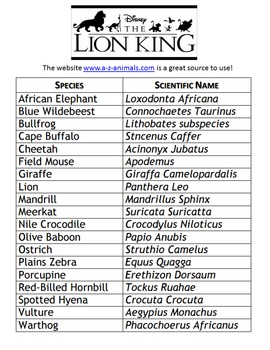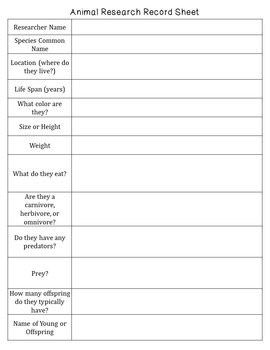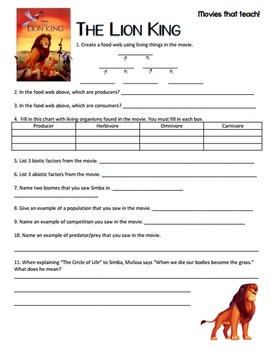The Lion King Ecology Research Project and Movie Guide Worksheet
- PDF
What educators are saying
Description
Lion King Ecology Research Project and Movie Guide
Download Preview File
View preview above
This Product Includes:
-list of species of animals in the move the lion king
-lion king species research record sheet
-lion king movie guide
-Movie Guide Answer Key
Description
This is a great activity for your Ecology Unit. We research the animals, fill out the research sheet, then watch the movie and complete the movie guide. My students love applying what they know from learning about ecology to this activity.
How to teach this lesson:
My students pick an animal from the movie off of the species list (included) and then research the species. Students record their data on the worksheet (included).
Then we watch the movie the lion king and students complete the movie guide showing their knowledge of ecology material.
Vocabulary Terms
Biome
Biomes
Herbivore
Carnivore
Omnivore
Predator
Prey
Species
Ecology
KEYWORDS
Biomes, Ecology, Lion King, Species, Animal Research
Resources You May Also Love ♥
Connect with Me!
Pin with me! Middle School Science
Terms
Copyright © Woodard Science. All rights reserved by author. This product is to be used by the original downloader only. Copying for more than one teacher, classroom, department, school, or school system is prohibited. This product may not be distributed or displayed digitally for public view. Copying any part of the product and placing it on the internet (even a personal/classroom website) is strictly prohibited. Failure to comply is a copyright infringement and a violation of the Digital Millennium Copyright Act (DMCA). Clipart and elements found in this PDF are copyrighted and cannot be extracted and used outside of this file without permission or license. Intended for classroom and personal use. See product file for clip-art and font credits.





